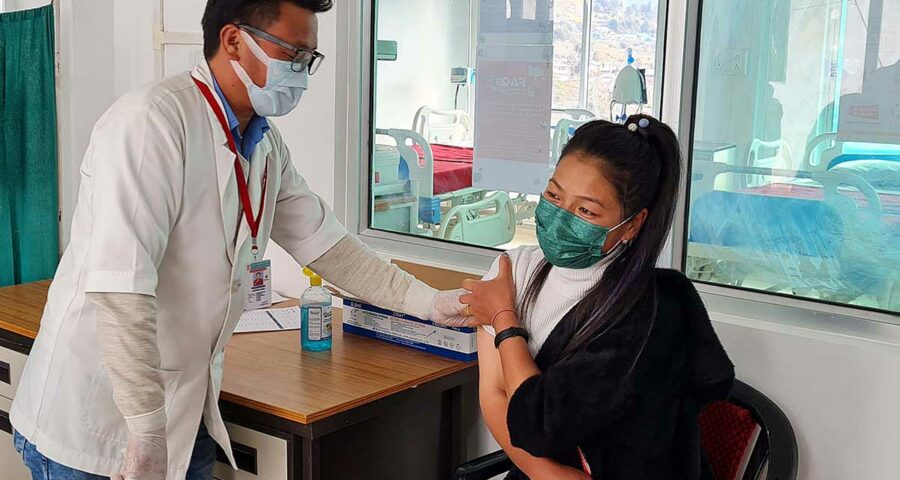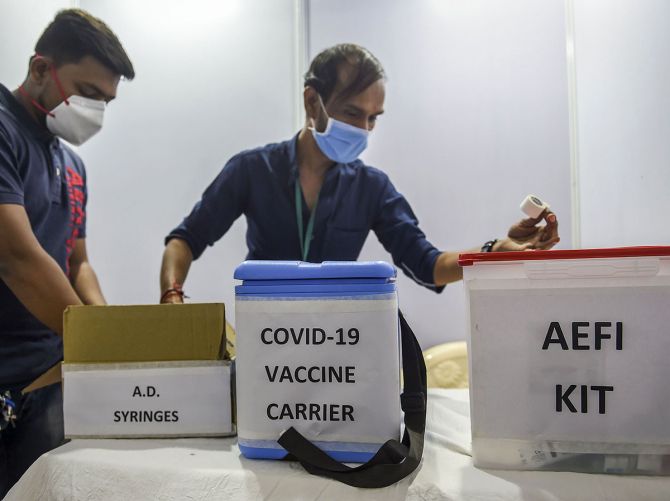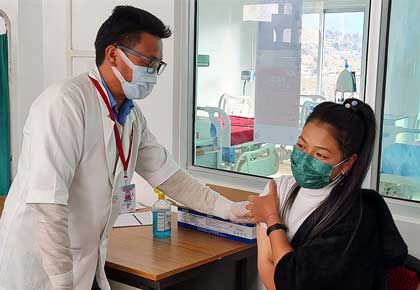‘Whenever you roll out: effectiveness is important, operational logistics are important, side effects are important and vaccine hesitancy is important.’
After ushering in 2021 with special toasts, it is a range of frosty bottles — not of any champagne or liquor — that will likely change our new year.
Vaccines against COVID-19, those brave little things housed in millions of tiny glass vials, at sub-zero temperatures, are destined to make all of our 2021s quite different from our ugly, forgettable 2020s.
And we can maybe move cautiously from darkness to light.
But just how much of a transformation will vaccines bring about in our everyday life in 2021?
A lot depends on which vaccine we Indians get to take.
There are over 300 types of vaccines against COVID-19 in various encouraging stages of development across the world.
The effectiveness of the already unveiled Pfizer/BioNTech ($20) and the Moderna ($33) mRNA vaccines are as high as 95 per cent.
This happy percentage was arrived at after the Pfizer/BioNTech vaccines was tested on as many as 42,000 volunteers and the Moderna vaccine on over 30,000 volunteers.
There are many logistical issues, however, that distance us Indians from receiving these two more capable vaccines.
And our chances of being administered a Pfizer/BioNTech or Moderna vaccine are slim.
So then what’s in store for us?
Public health doyen Dr G V S Murthy, in an interview to Vaihayasi Pande Daniel/Rediff.com, outlines why one vaccine differs from another and why even after receiving a vaccine, we may still need to keep our masks on.
Hyderabad-based Dr Murthy is the director, public health at the Public Health Foundation of India/Indian Institute of Public Health, a well-known non-profit striving towards ‘healthier India’.
Simultaneously he is a professor in public health disability with the International Centre for Eye Health at the London School for Hygiene and Tropical Medicine, London.
Dr Murthy earned his degree in medicine and his specialisations from Guntur, New Delhi and London and is a public health physician by discipline.
He has been/is the principal investigator of over 40 community health projects in India, Nigeria, Bhutan, Nepal, Bangladesh and Pakistan.
Even as he works on more routine public health issues, related to diabetes or eye problems, Dr Murthy provides technical advice on COVID-19 to the WHO and is a member of technical advisory groups on COVID-19 in India.
Dr Murthy lucidly explains that given the cost and cooling constraints, Indians will be most likely inoculated with an easier-to-administer but less effective killed virus vaccines.
These killed virus vaccines, when they finally reach us, maybe by mid-2021, will afford us some protection, but not a whole lot.
Therefore, Dr Murthy says, masks and social distancing will be needed and be vital to take us safely through 2021 too.
“I hope you are using a mask regularly?! I would not talk to you if you are not wearing a mask!” Dr Murthy gruffly warns this reporter.
So, folks, masks are here to stay for the time being, even if vaccines are destined to make all our tomorrows much better.
What aspect of COVID-19 are you more focused on?
We are waiting for the large-scale effectiveness trials to start (for the vaccines that India would be eligible for).
At the moment what we have is just limited data on Phase 1 and 2.
For Phase 3, the data has not yet been released.
Once that is done, then we must have effectiveness.
There is a difference between vaccine efficacy and vaccine effectiveness.
Vaccine efficacy is what you do in lab conditions.
You’re working with monkeys, chimpanzees, mice, all of that.
And then with the people who are going to receive the vaccine, who are all in a hospital-controlled environment.
The real challenge starts when you carry the vaccine into the field.
That part is called effectiveness.
A vaccine might be 100 per cent efficacious, but when you try to take it into the field, it will drop to 50 or 60 per cent.
That’s because either the cold chain is not working.
Or the way it is administered is not correct.
Or it is getting damaged very quickly with the temperatures that we have in a country like India.
All these things come together, when it has effectiveness.
None of the vaccines, that we have developed or are developing in India, have come to the effectiveness stage.
We waiting for that right now.
You’re working directly on a project or are you an advisor?
We are advising.
We are not a biotechnology institute.
Once the effectiveness trials start, then we will be involved.
As long as it is lab-based development, we are not a part of it.
There are various ways in which the government is preparing for India to be vaccinated.
In your view, how is the organisation for this programme working out?
What are the areas where a little bit more attention is needed, apart from the problem aspects with effectiveness, that you just mentioned?
Most important, we, at the moment, don’t know which vaccine is going to be rolled out for the Indian population.
Nobody’s clear; nobody’s talking about that.
We’re making six or seven prototypes.
But which vaccine is finally going to be used is the big question, which will be related to the delivery of the vaccine.
The vaccines that are currently being rolled out in the US or UK — both the Pfizer vaccine and the Moderna, which the US will be rolling it out — both are very different vaccines.
They take a nanoparticle and synthetically develop it, from the proteins that are available, in the genetic sequence of the coronavirus.
Because of that process, till the time of delivery of the vaccine, that is till you get the shot, the vaccine has to be kept at -70 C, which is in a deep freezer.
Now, how do you carry deep freezers into Pulgaon, Wardha district or some village near Lonavala in Maharashtra?
How do you carry these deep freezers about?
They need electricity.
Ice-lined refrigerators will not give you -70 C.
Those are the challenges, depending on which vaccine is going to be used.
If you are going to use the ICMR Bharat Biotech one, that is an inactivated or killed virus vaccine.
The virus is killed, it is inactivated and then you’re given the injection dose.
Those generally have very, very poor efficacy, forget effectiveness.
The efficacy of most of these inactivated virus vaccines will not go beyond 70 per cent, which means by the time it goes into the population, its efficacy will be around 50 to 60 per cent, like the old cholera vaccine.
Delivering that vaccine is easier, but the immune response delivering the antibodies, which will protect you, is much poorer It is very, very inefficient in developing that.
So, at the moment, we haven’t seen any Phase 3 data from India coming out.
Even preliminary results have not come out.
So, the very first question is: Which vaccine does India propose to use?
Based upon that, how you roll it out would need to be planned.
If it is the inactivated virus vaccine, the big challenge would be — because it will have lower effectiveness — that you will need to at least administer the vaccine to 80 per cent of the population, to see that the transmission chain of the COVID-19 virus is stopped.
If that is above 80 per cent, then even if the vaccine is poor efficacy, the chances of infecting other people is going to be low.
But if you are not able to achieve 80 per cent vaccination coverage in the field, then it will be very difficult to stop the transmission.
At the moment what these vaccines are doing — they are not preventing infection.
Not one of them is preventing infection.
All the candidate vaccines what they are doing is reducing the severity and progression.
So, if you get infected by SARS-CoV-2, then you will not go into a moderate phase of COVID-19 or serious illness of COVID-19.
That is what the current lot of vaccines are doing.
Now, we did it with the cholera vaccine also — right across the country, in the same way.
We’ve had so many cholera epidemics till 1990.
And every time — the cholera vaccine was an injectable vaccine at that time with 30 per cent effectiveness and 50 per cent efficacy — was given routinely.
The entire health system was put on the job of immunising.
But here the problem is that you will first have to immunise the health personnel and other frontline workers handling immunisation, before you actually roll it out to the rest of the population.
It is going to be a two-phase immunisation process — first, starting off with those who are going to deliver the vaccine and maintain law and order, and then go on to the rest of the population.
We will need to identify two clear windows — first for the frontline workers or those with higher morbidity, like in the UK right now, where they are immunising those above the age of 80 years and those who have comorbidities.
So, those are small numbers, and you can easily reach them.
Once you decide that the whole population has to receive it, after all the high-risk groups are covered, that is when the challenge will come.
As to how you are going to carry it to the different villages and to the different primary health centers.
In terms of facilitating the delivery, it is not a problem.
You could have immunisation days, where the whole village comes together, over a period of three to four days and a population of 1,000 can be easily covered.
About one to three per cent will have mild symptoms — fever or pain at the site of injection and cold and those sort of things.
Those are very minor side effects.
But at least one in 1,000 can have more serious side effects.
It could be cramps of the abdominal muscles to even fainting, like we’ve seen in the US, where some people fainted.
So, there could be a wide range.
At the moment, there is no data now to say how the India-developed vaccines are going to be.
Excepting the Astra-Zeneca Oxford vaccine, which has also been tried in other countries like Brazil, UK and for which there is some data coming from outside India.
But within India, they have not had any Phase 3 data at all.
Once you have that, and there are some side effects, then immediately people will refuse to take it.
We saw that with the measles in the US.
Children were not being immunised, parents refuse, and we had an outbreak of measles.
The same thing can happen.
That is what we call vaccine hesitancy
Whenever you roll out: effectiveness is important, operational logistics are important, side effects are important and vaccine hesitancy is important.
If all these four you are able to tackle, then the actual delivery is not going to be a problem, because we have a huge army of people who can deliver it.
But it is these four things, that I have mentioned, which would be the biggest challenges.
And those challenges can only be addressed, if you know what vaccine the government is planning to use in delivering.
So, none of these questions are yet answered.
The plan for Delivery India is ready — to deliver the vaccine, free, paid, whatever it is.
But before that: What vaccine are we going to use?
That has to be clear, which is not clear as yet!
Update: After this interview with Dr Murthy was conducted, the Government of India has announced plans for a dry run of the COVID-19 vaccine and said it has approved the ICMR-BioTech for emergency use.
Says Dr Murthy: “Yes, the government has now indicated its preference for the two vaccines, of which the Serum Institute vaccine may be first off the block, even though Phase 3 trial data is not completely available for both vaccines.”
“However, for the Serum Institute vaccine, the UK trial data has also been considered. The production capacity of the Serum Institute, Pune, being high, it is likely to be the first vaccine that will be rolled out.”
“It is still not clear whether there will be a geographical distribution for the two vaccines — one vaccine for one region and another for another region.”
“Both vaccines will be similar in the way they produce immunity.”
“There is a worry about the side effects, which have not yet been declared for the Bharat Biotech vaccine. These details may be expected in a couple of days.”
“Since the vaccination process is not going to start immediately, we will know whether it is safe or not before that.”
“One thing is certain as of now: Serious adverse effects do not seem to be high with either vaccine.”
- THE WAR AGAINST CORONAVIRUS
Feature Presentation: Ashish Narsale/ Rediff.com
Source: Read Full Article




